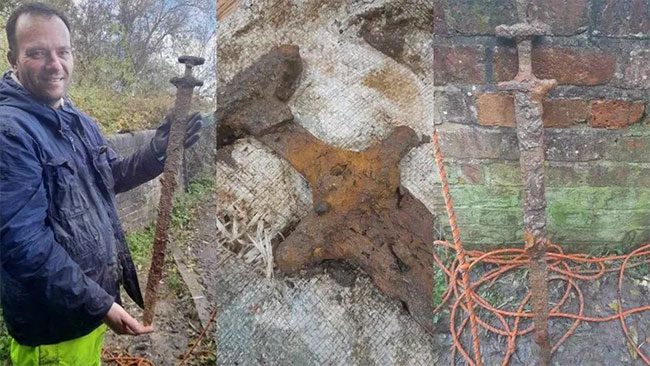Experts have confirmed that the ancient sword discovered beneath a river in Oxfordshire is a Viking weapon “rare from an archaeological perspective” dating from 850 to 975 AD.
In November 2023, fisherman Trevor Penny unexpectedly encountered a rare fortune while using a magnet device to search for valuable lost items at the bottom of the Cherwell River in Oxfordshire, England.

The 1,100-year-old Viking sword found by fisherman Trevor Penny at the bottom of the Cherwell River in England. (Source: livescience).
Penny’s device pulled a metal object from the riverbed that he initially did not recognize, until his friend exclaimed, “It looks like a sword.”
Penny uploaded images of the sword to Google’s image search and received results indicating it was from the Viking era. He then reported the find to a local official to contact experts in archaeology to examine the sword.
The examination results later confirmed that this is indeed an ancient sword – a Viking weapon “rare from an archaeological perspective” – dating from 850 to 975 AD.
Although there was a dispute between fisherman Penny and the landowner River Trust, who prohibited magnet fishing in their area, both parties ultimately reached a conciliatory conclusion.
The landowner, River Trust, stated they would not take legal action if this rare artifact was handed over to a museum, and Penny agreed to return the Viking sword to the Oxford Museum.
Experts from the Oxford Museum noted that from an archaeological standpoint, “it is very rare to find an ancient sword of such historical significance still intact.”

The Viking sword dated from 850 to 975 AD. (Source: livescience)
The discovery of the Viking sword in the Cherwell River provides authentic evidence of the presence and activities of Vikings in England, offering historians and archaeologists valuable insights into the culture, weaponry, and craftsmanship of that period.
Further study of the ancient sword will contribute to a deeper understanding of the Viking Age and their interactions with the British Isles.
The Vikings landed in England in the 8th century, beginning with a raid on a monastery on Lindisfarne Island, an island off the northeast coast of England, in 793.
Following this, this fierce army conducted a series of raids in the British Isles, escalating after 835, when larger Viking fleets began to land on the English coast and engage the royal army.
Throughout the 10th century, English kings gradually reclaimed territories held by the Vikings and unified these lands into a new kingdom called Englalond.
However, invasions and Viking rule persisted until the 11th century, and the Viking Age only ended after the Battle of Stamford Bridge in 1066, with the defeat of Norwegian King Harald III Sigurdsson by the Saxons.
The ancient Viking sword is currently preserved at the Oxford Museum and will soon be displayed for public viewing.


















































